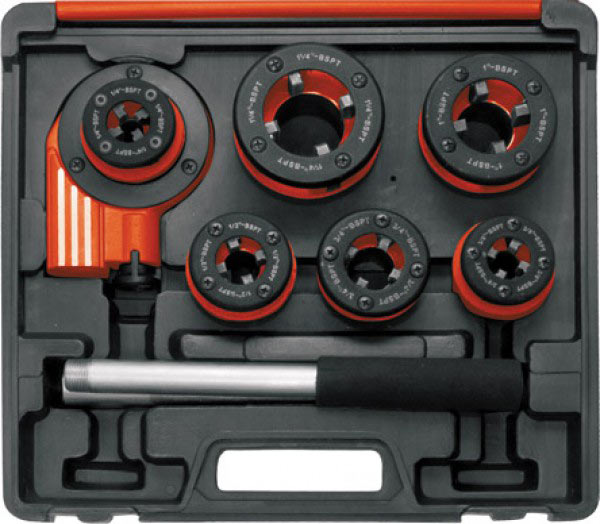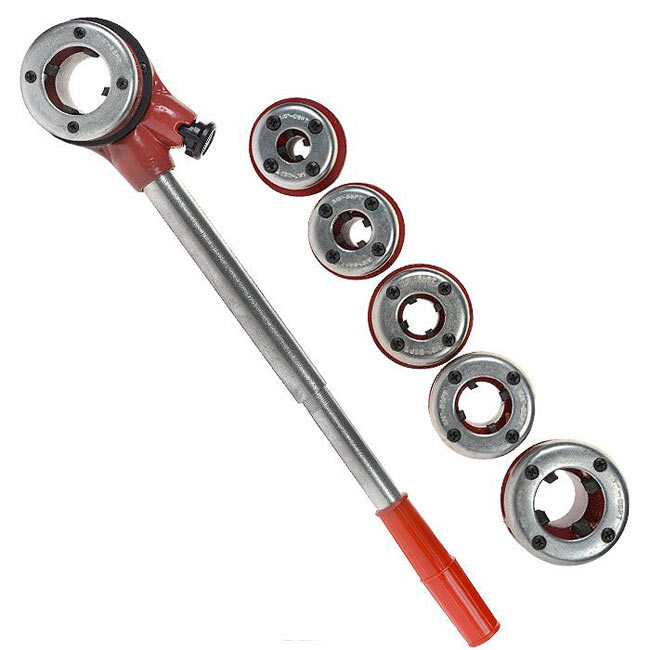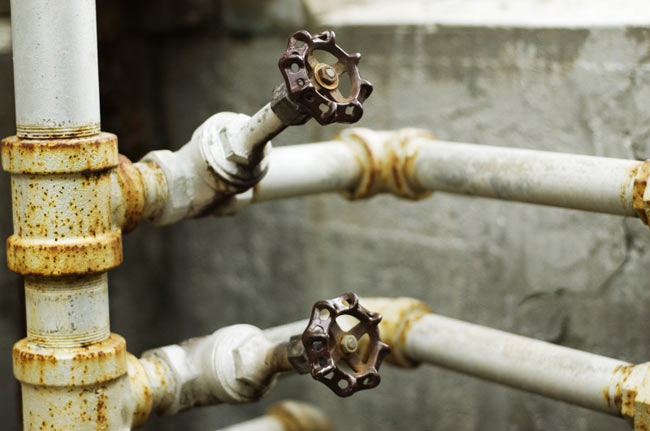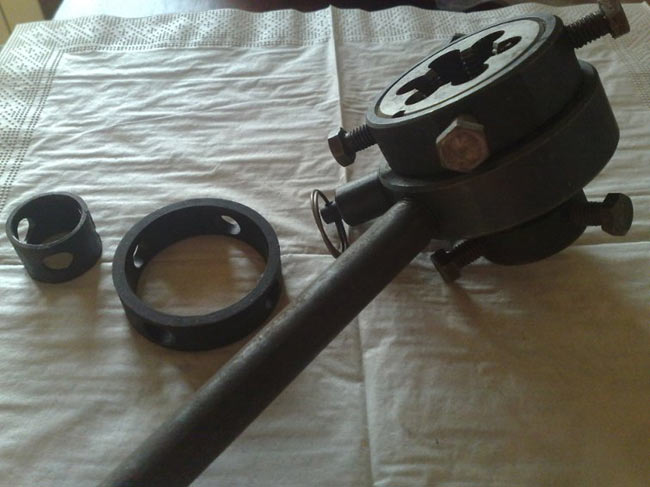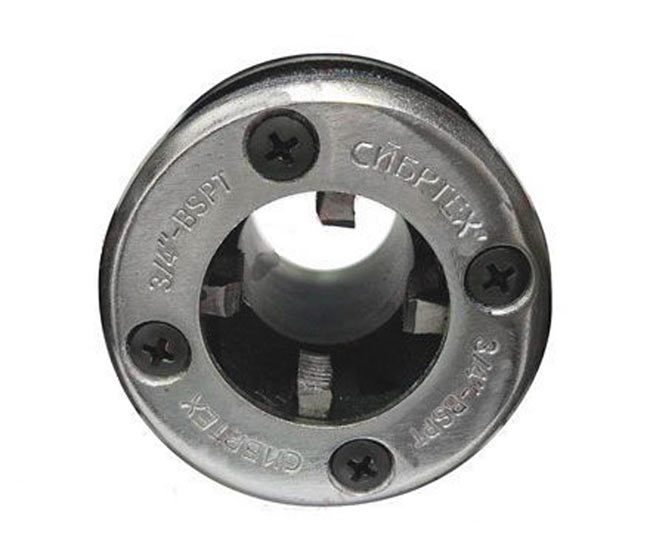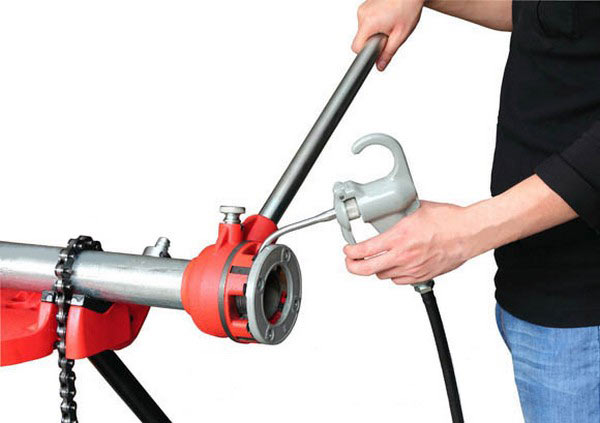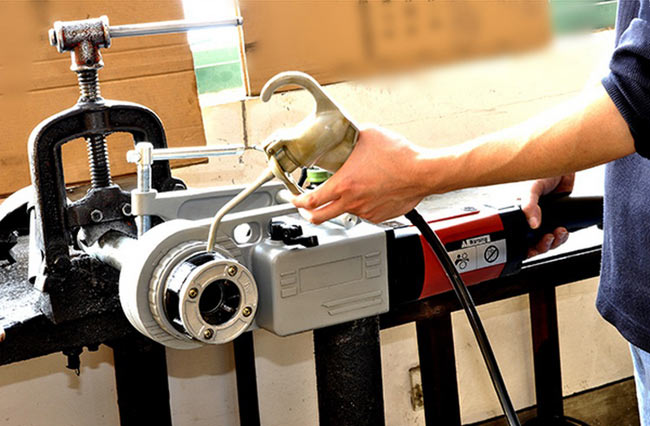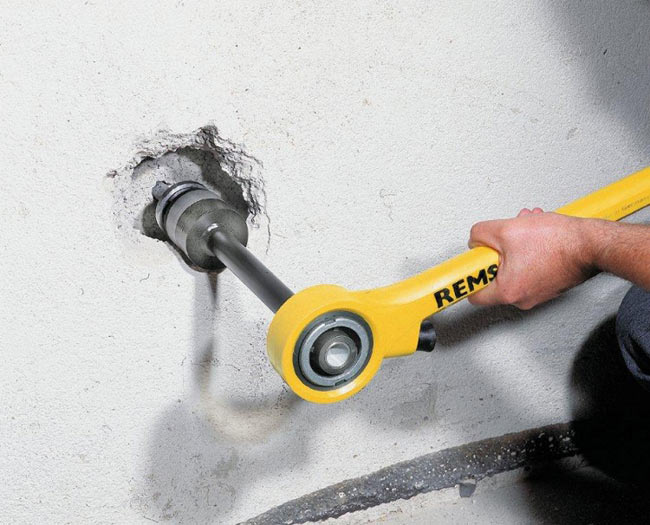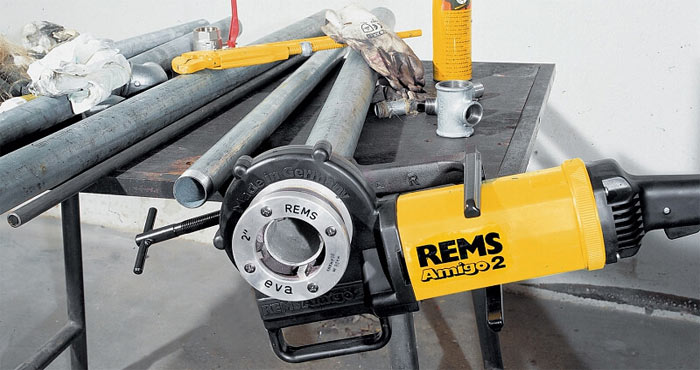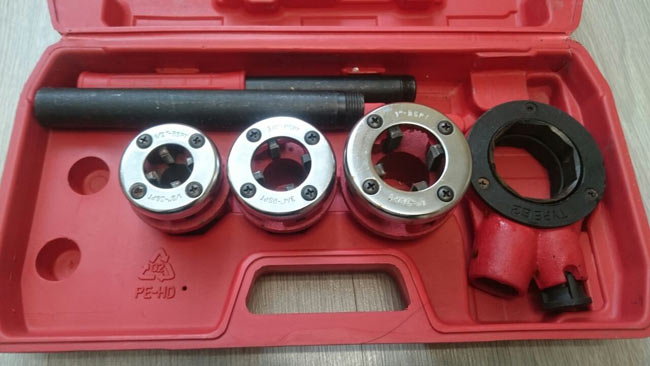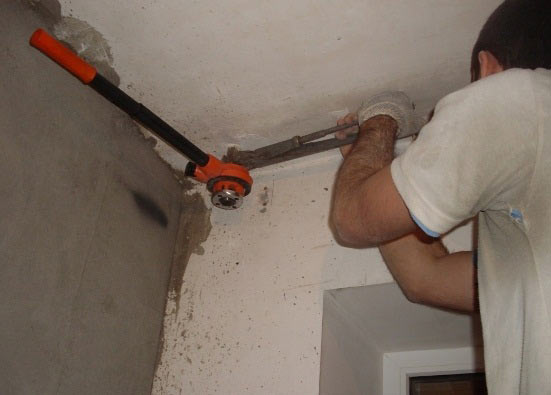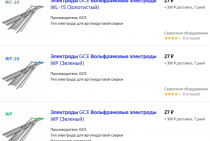Klupp pipe types
Despite the simple structural device, a wide variety of both simple mechanical and electrical various types of models is presented in the distribution network. Typically, klupps are sold in sets that differ in the number of heads.

Rice. 7 Mechanical screw plugs with ribs for a gas wrench
Manual mechanical
As noted above, screw cutters are sold in sets; for one-time work, it is possible to purchase a head of the desired diameter in a single copy. In this case, it is wound onto the pipes with a gas wrench with ribbed jaws that cling to four protrusions on the cylindrical head.
In the distribution network, die holders of a standard design are sold, having screws around the perimeter for fixing the head and two branch pipes with internal threads into which handles are screwed. In the absence of a ratchet, they can be used to turn the screw head with the diameters matching, fixing it with fixing bolts. It is clear that such a device is quite difficult to cut in hard-to-reach places.
Hand ratchet
This is the main type of screw cutters sold in the distribution network, the ratchet allows you to rotate the head with a small angle of rotation of the handle. The main difference in ratchets is a different number of teeth, the larger their number, the smaller the angle you can turn the handle. Each ratchet has a reverse function for turning the head in the opposite direction.
Electrical
Power tools are classified as professional, with its help you can cut large volumes of pipe threads. Usually, the standard kit includes an electric drive, at least 4 heads and a clamp, which is screwed to the pipe and the unit is fixed in it.
The head of the electric screw has a tablet-like shape with a protruding cylindrical coupling of a hexagonal (octahedral) or other shape. The electric drive makes it easy to thread short pipe sections (do not use a clamp for this) with inverted dies without first chamfering the outer edge.

Rice. 8 Electric die cutters in operation
How to choose a pipe die for threading a pipe
The main task of the tool is to make a threaded connection on steel pipes. This result can be achieved only by using high quality dies. Even if it becomes necessary to cut threads in a single quantity, then buying a cheap screw cap (ratchet kit) is not the best option. In this case, it is better to buy a pipe screw without a ratchet, which will be of high quality than the dies in the set. Many people step on such a rake when it becomes possible to purchase a whole set of thread-cutting dies on pipes instead of one screw die.
When buying pipe threaders, you need to pay attention to a number of the following parameters:
- Price. Sets of cheap klupps in a set are like cheese in a mousetrap. The probability that it will not be possible to cut a thread with such a tool even on one copy is 99.9%
- Possibility to change blades. Most manufacturers leave the opportunity to change the cutters, continuing to use the tool further. Sooner or later the cutters will become dull and fail (even with high quality steel), so the ability to replace them is a great advantage.
- Cutting material. If you buy a set, then it must be accompanied by instructions, as well as the technical parameters of the tool. The cutters must be made of high quality, strong and alloyed steel, which affect the ability to cut threads in large volumes.
- The presence in the set of dies for cutting threads on pipes of different diameters. If you often work with pipes with a diameter of more than 1 inch, then you need to look after the appropriate set
- Manufacturer. To make sure the quality of the tool, you need to buy devices only from trusted manufacturers. The most popular pipe die manufacturers are: YATO, Zubr, SIBRTECH, Truper and others
It is interesting! Before buying certain models of klupps, be sure to read reviews about them. Only if there are positive reviews, you can make a decision to buy a pipe screw die on the Internet or on the market.
Why is this required at all?
Despite the fact that the 21st century has come relatively long ago, and the store shelves are full of various modern materials for gas and water pipes, carving as such is still relevant. It has been used for a long time, but still there is no reason to refuse its use.
However, all plastics (including composites based on them) are characterized by two significant drawbacks.
- First, they are contraindicated high temperature. For example, the "ceiling" for polypropylene is only +90 degrees. This is so, you will notice, but in accordance with the norms and requirements in the pipelines of residential buildings there should not be a higher temperature; that's right, but in many northern regions, due to cold winters, thermal workers have to exceed these norms, otherwise people can simply freeze. And if the temperature in the plumbing / heating system exceeds +100 degrees, that is, the boiling point of water, then polypropylene in this case cannot be used at all. As for PE pipes, for them the maximum allowable temperature is only +40 degrees.
- Secondly, the mechanical strength of plastics/composites is low. And if the pipeline needs to be laid, say, under a popular road or in a restaurant toilet, where it can be damaged by drunken visitors, then the use of plastic must be abandoned altogether! The same applies to metal-plastic pipes, which can be easily deformed or removed from the fitting.
What options are left? Unfortunately, only steel. Of course, it is better to give preference to galvanized ones, since rust in the pipeline is certainly superfluous.
Note also that there are two ways to achieve a tight connection of steel pipes:
- use a threaded connection;
- use welding.
At the same time, not everyone can boast of having a welding machine; in addition, after welding, the protective zinc layer is broken. And this leads to rusting of welds. Therefore, such a water pipeline will initially have vulnerabilities.
Klupp what is it
So, klupp is a fairly effective device used in the installation of pipeline systems. In principle, it is a die familiar to us (or “lerka”, as it is also called). The fixture consists of a small cylindrical part with a recess to bring the chips out during threading. In addition, there is also a recess around the entire perimeter of the instrument, which is necessary for a comfortable clamping with a holder. Combs are located inside the tool, which, in fact, form the thread.
What is the difference between the described device and the same die? The fact is that in the first case, only cutters remained from the die as the main functional part of the device. And they are attached directly to the holder, and he, in turn, acts as a guide.
Popular models of klupps, characteristics and prices
Let's get acquainted with the characteristics and cost of some popular klupps. For the convenience of site visitors, the information below is presented in the form of a small table.
Table. Popular klupps and their average market prices.
| Name, photo | Short description | Average market value, rubles |
|
1. "Zubr EXPERT 1/2" 28271-1/2_z01" |
Designed for metal pipes of standard diameter. For the manufacture of cutters, high-quality alloy steel was used, which ensured excellent strength characteristics. Product dimensions - 7x7.5x7 centimeters, weight - 670 grams. | 697 |
|
2. Sturm 1065-04-1-1/2 |
High quality model made of extremely durable material. The cutters are hardened, made of tool steel. Product dimensions - 11.4x12x10.8 centimeters, weight - 2.05 kilograms. | 1 300 |
|
3. 1 1/4″ PROFESSIONAL STAYER 28261-5/4 |
It is characterized by replaceable cutters, made of high-quality high-strength steel, and therefore has a long service life. Easy to use, quickly cleared of metal chips. Product dimensions - 9.5x9.5x9.5 centimeters, weight - 880 grams. | 753 |
|
4. 1″, FIT 70034 |
The product is made of high-quality tool steel, designed for cutting external threads on pipes with a diameter of 1 inch. The dimensions of the device are 8x8x8 centimeters, and the weight is 500 grams. | 614 |
|
5. 3/4″ SIBRTECH 77367 |
This model allows you to quickly and efficiently cut external threads and is designed to be used with a ratchet wrench. The dimensions of the product are 37x16x17 centimeters, while it weighs 600 grams. | 687 |
|
6. SANTOOL 1″ 032116-001-001 |
The latest model for today, which is also designed for threads with a diameter of 1 inch. The dimensions of the fixture are 7x7x7.5 centimeters, and the weight is 660 grams. | 784 |
Expert advice
When choosing a tool for threading pipes and carrying out threading work, it is useful to heed the following tips:
- The main criterion for choosing a die is the amount of work carried out, the diameter of the pipes and the quality of the steel. With the help of a budget die cutter, you can thread pipes made of low-carbon steel grades St2 - St5, for cutting harder carbon grades St10, St15, St20 and stainless steel, you will need high-quality cutters and, accordingly, more expensive tools.
- If you need to cut threads into relatively soft pipes made of low-carbon steels in small quantities, purchase a budget die separately to rotate it with a gas wrench.
- Mechanical budget Chinese die cutters are unsuitable for threading in significant volumes, especially for pipes of large diameters, where significant physical effort is required. Since their cutters are usually of poor quality, too much physical effort has to be applied to rotate the head - thus increasing the likelihood of breakage of the die body in the ratchet assembly or in the place where the handle is screwed.
- For the simultaneous application of pipe threads in large volumes, the best option is to rent an expensive high-quality thread cutter (REMS, Ridgid).
- The best option in terms of price and quality is the purchase of good branded plugs from Chinese manufacturers (Hongli) or not too expensive European brands (Virax). In any case, their cost is several times higher than the budget die cutters.
- The exact criteria for determining when the thread-cutting dies have lost their sharpness are the application of great physical effort during the work and the appearance of a torn edge at the thread. In this case, the cutters are replaced with new ones by unscrewing the four screws on the head cover.

Rice. 12 Electric screw plugs - cost 2019
carving
Scope in the household
Although a pipe cutter is classified as a professional tool, its use in everyday life can be useful for home craftsmen involved in various kinds of crafts. Given that there are two main types of steel pipeline connections - welding and threading, the latter has a significant advantage, since it is collapsible. In a suburban household, a thread-cutting die can come in handy in the following situations:
- For cutting threads on pipes, which are the frame of collapsible structures - greenhouses, greenhouses, arbors.
- When installing an internal plumbing system for supplying cold and hot water from galvanized steel, stainless, copper pipelines.
- For arranging a heating system using steel, copper, stainless pipes when using them as a pipeline transporting a coolant for supply to radiator batteries.
- When laying a gas pipeline inside the house, a threaded connection will be needed to connect the external input to the house, the gas stove to the line.
- For cutting pipe threads on various parts of home-made machines, technical devices, in some cases on polymers (thick-walled polypropylene and low-pressure polyethylene).
- In the presence of caisson wells for cutting threads on metal pipes inside the caisson or diverting water for irrigation to the surface.
- Some craftsmen independently drill wells in their areas, for this they use metal rods from pipes that are joined together by threaded connections. The best and, perhaps, the only tool for threading this type of tubular elements is a manual or electric die cutter.

Rice. 3 End cutting through the extension and with a spanner
A few more words about the principle of action useful recommendations
Summing up all of the above, let's briefly go through the main stages of thread formation again (here the procedure will be described with a conventional pipe, and not with an already existing pipeline).
Stage one. First you need to take the pipe and carefully fix it with special clamps.
Stage two. After that, the end of the pipe where the thread will be made must be thoroughly cleaned, lubricated with something, and then the fixture knob should be installed there.
Stage three. Next, the device must be rotated, while applying considerable effort. This must be done until the thread of the required parameters is obtained.
It should also be noted that using the tool described in the article, you can cut both metric and inch threads. It is quite obvious that in the first case it is measured in millimeters, and in the second - in inches.
To extend the service life of the die cutter, we recommend that you adhere to the requirements below.
Replace parts of the tool that are already worn out in time.
When choosing a tool, take into account the parameters of the product on which the thread will be cut
It is important that both fit each other in size.
And if the klupp is smaller than the pipe, then strong friction is formed during operation, due to which the cutters can be deformed.
Periodically, the device must be lubricated, for which a special lubricant is used. The latter is necessary in order to cool the incisors
So you protect them from overheating and, as a result, deformation.
As a result, we note that the klupp is a professional tool, and therefore it should be handled in accordance with the operating rules. When choosing a particular device model, you must understand how it works and what manipulations you can perform with it. Knowing what material the pipe is made of, what its dimensions and technical characteristics are, you can choose the right tool from a wide modern range. And if you also use it carefully, you will ensure that the klupp will retain good condition and original characteristics.
That's all. Be sure to watch the related video below. Good luck!
What is a pipe screw
Klupp is called a thread-cutting tool, which is a cylindrical head of complex shape, inside which are placed removable comb cutters for threading.
The design of the klupp can be conditionally divided into two parts: the first contains a head with a removable plate and four thread-cutting dies, the second is a cylinder, usually with four external edges or a hexagonal (octagonal) surface, which is first put on the pipe.
Also included in the kit of any die is a device for its rotation (ratchet) in the form of a head with a handle, which is placed on the cylindrical part of the tool with edges.The ratchet allows you to wind the screw cap on the pipe without rotating around its axis by 360 degrees, which is very convenient when the pipeline is located next to stationary objects.
Clupp for threading pipes is usually equipped with several dies of different diameters, their standard sizes are 1/2 (15 mm), 3/4 (20 mm), 1 (25 mm), 1 1/4 (32 mm), 1 1 / 2 (40 mm), 2 inches (50 mm), of which the first four are the most popular with the consumer.

Rice. 2 What is a klupp - the main components of the REMS ratchet model
Thread cutting with a hand screw
There are two options for threading pipes depending on their position, which can be fixed in various technical structures, building objects, and mobile, placed in a clamping tool. In the latter case, a vice is often used, the disadvantages of which include the possibility of surface damage and deformation of the shape of parts.
The world's leading manufacturers produce special nipple clamps with an expansion head, which is inserted inside the pipe. When the rod associated with the expander is rotated, the head increases in volume and is firmly pressed against the inner pipe walls, while not the part, but the clamping nipple itself is fixed in a vice.
Threading operations on transported pipes by means of a die cutter are carried out in the following sequence:
- Cut the pipe at a right angle, trying not to leave burrs. In order to accurately maintain an angle of 90 degrees, wrap the shell of the part at the cut point with a tape of any adhesive material or a fixed strip of paper until the ends are aligned, after which the workpiece is cut exactly along the edge of the template.
- The part is fixed in a vice, leaving the end about 100 mm free, special oil from a cylinder is applied to the edge and a screw lehr is put on the workpiece, previously placed in the ratchet mechanism.
- Pull out and turn the locking pin of the ratchet to the working position in the direction of the arrow.
- Press on the screw nozzle from the side and start the slow rotation of the device with a regular supply of oil to the working area. When carrying out work, only special branded oil is used, which washes away the chips, and does not stick them to the turns, worsening the quality of the cut.
- The ratchet continues to rotate until the lerks are in the same plane with the pipe end - this is the standard length of the tapered thread.
- After penetration, the locking pin is moved in the direction of the arrow to the reverse position and the head is rotated in the opposite direction, completely unscrewing, after which the cutting is ready for use.

Rice. 9 Threading steps
Popular models of pipe clamps
There is a wide range of inexpensive klupps of mainly Chinese production on the market, there are domestic and much more expensive brands from European manufacturers, the USA.
Usually, a tool for threading pipes is sold in sets, the elements of which are placed in a suitcase for transportation, the standard package includes several nozzles and a ratchet with removable handles, a bottle of branded oil. Most often on sale you can find kits and individual clamps of the following brands:
ZUBR is a Russian brand with production in China, the company produces both individual threading lerks and sets. On sale are sets of the Expert series with lerks in the amount of 3, 4, and 5 pieces with average prices of 3,000, 4,000 and 4,500 rubles, respectively. Thread-cutting heads are covered with red powder paint, in the distribution network their cost is from 600 to 900 rubles.
The cutters, according to the manufacturer, are distinguished by improved geometry and are made of standard steel grade 9XC, the main type of thread being made is conical pipe. Standard sizes and the corresponding number of screw plugs are 1/4″ or 3/8″, 1/2″, 3/4″, 1″, 1 1/4″, products are guaranteed for 1 year.
SIBRTECH is a Russian brand with production facilities in China, individual steel-colored heads of standard sizes and ratchets are available for sale.SIBRTECH pipe clamps are notable for their low cost (lehrs can be bought for 350 - 600 rubles, ratchets for 850 rubles), they are mainly designed for cutting self-sealing BSPT threads and much less often cylindrical BSPP.
Delivery in separate parts is convenient for use in the household - you can buy a ratchet and one or two heads suitable for it, which will be much cheaper than a complete set in a case.

Rice. 10 Cost of die cutters 2019
FIT is a trademark of a well-known Chinese manufacturer of various tools, the company produces inexpensive screw sets in cases and without in the amount of 3 to 5 nozzles with sizes in inches 3/8″-1/2″-3/4″-1″-1 1/ 4". The elements are made of tool steel, the product has the lowest cost - a set of 5 lerok can be purchased for 3000 rubles.
In addition to this brand, there are also Chinese-made products on the market with similar physical parameters, workmanship and prices of quite well-known brands Matrix, Sparta, Sturm.
Hongli is a product brand of a Chinese company that supplies high-quality tools to the domestic market. A die-cutting set for threading includes threading heads in sizes 1/2 ″ -3 / 4 ″ - 1 ″ - 1 1/4 ″ - 1 1/2 ″ - 2 ″, its average cost is 19,000 rubles.
Hongli is a supplier to the Russian market of high-quality threading power tools of the SQ30 series, the cost of which in a case with four heads is just over 25,000 rubles.
Virax is a brand owned by a French company that is the world's leading manufacturer of power tools. A hand-held set of four-head die cutters in sizes 1/2″ - 3/4″ - 1″ - 1 1/4 ′′ in a case is designed for cutting right-hand tapered BSPT threads, it can be purchased for an average of 14,000 rubles.
Virax is also a well-known supplier of thread-cutting die-cut power tools costing from 55,000 to 75,000 rubles, the standard package of which includes 4-6 leroks, respectively.
REMS is a trademark of the German concern, one of the leading manufacturers of tools; on the domestic market, it is perhaps the most expensive and of the highest quality.
The REMS Eva series hand-held die cutters, in their characteristic yellow colour, allow taper threads in standard sizes from 3/8″ to 2″ as well as bolted threads from 1/4″ to 1″ to be applied to pipes. The ratchet handle is made of hardened steel with a protective plastic coating, equipped with a rubber grip to prevent slipping of the hands. A set of 7 dice in a metal case can be purchased at a minimum price of 22,000 rubles.
In addition to hand-held threading tools, REMS supplies the market with a wide range of similar power tools from the Amigo series at a high price even for professionals. The price of a kit with an electric drive starts from 70,000 rubles. and can reach up to 150,000 rubles.
The market also offers high-quality electrically driven thread-cutting tools from well-known manufacturers such as Ridgid (USA), Rothenberger (Germany).

Rice. 11 Prices for popular klupp sets 2019
Manual and electric screw cap functionality and features
The functional purpose of various types of die cutters is fast and high-quality threading on pipes of various diameters. Klupp is the main functional part of an ordinary die (or, as it was previously called for quite a long time, lerks): these are cutters that are fixed in a holder that simultaneously serves as a thread guide, or (for some manual models) rotate with a gas wrench.
Manual klupp
The most common hand-held die is an ordinary die in a simple holder: threading is carried out by installing strong cutters on the end of the pipe being processed and rotating them by the handles of the holder. Traditionally, the holder is made of two metal rods that are grasped with two hands, but there are also tools with a single handle - they are comfortable to rotate with one hand, and therefore it is convenient to use even in hard-to-reach places. The cheapest models are produced without holders - when cutting, such screws are rotated with a gas wrench of a suitable size.
There is also a modification with a ratchet, which is inserted into the frame of such clamps.These tools allow during operation not to remove the handle from the holder after each threading turn - when the ratchet lever is turned, the screw die is quickly and easily removed from the thread by reverse rotation of the handle.
electric klupp
An electric die cutter is a professional tool and, like a manual one, is used to make threads on metal and metal-plastic pipes of various diameters. At the same time, the use of physical effort, as in the case of a manual screw clamp, is not required - the work is not only easier, but also much faster, it is enough to securely fix the pipe, install the screw clamp on it and press the start button of the electric drive.
Insignificant, it would seem, the power of the electric screw cap allows you to develop a huge torque. The only drawback of the electric screw plug is the dependence on the power source and the inability to use it in the rain or with significant humidity.
What can be used for threading
If we consider the process in terms of labor and time costs, then the best option would be not a pipe die, but a lathe. You just need to place the pipe in the spindle, then tighten it, cut off the excess with a cut-off tool, align the edge, and only then, after changing the tool, select the parameters of the required thread. Basically, that's all.
But not everyone has the opportunity to use a lathe. Therefore, only manual devices remain - a die and a klupp considered in today's article. But in addition to these tools, you will also need something in order to cut the pipe. And this can be done both with the help of a pipe cutter, and with the help of a manual turbine or an ordinary hacksaw.
The advantages of a klupp over a simple die
The usual die is made of expensive tool steel. In this case, only the cutters must be especially strong, because they form the thread. And the klupp, as we noted earlier, is also a die, but already without expensive and non-functional elements. An inexpensive holder, as well as durable cutters - that's all that is required in this case.
It would seem illogical to consider a tool as a budget alternative to a plate: you can find klupps on the market, the cost of which is measured in thousands of dollars. But do not forget that the incisors here are interchangeable elements.
What is the savings anyway? on consumables. As for the tool, its cost is so high for the reason that it makes the threading process less tiring and more convenient.
A few important nuances
There are some nuances in the use of a pipe screw die, as well as any other tool.
- Before starting work, the pipe must be rolled (in the same way as with a die). There are many ways to make one end of the pipe a little thinner - this is the use of a file, an impeller, etc.; you can also just take a hammer and flatten the end a little using an anvil. Another common option is common through a gas key.
- If the pipe where the thread is to be cut is part of an existing pipeline, then it must necessarily be held by a gas wrench in order to compensate for the torque during threading.
- And if you smear a little grease or even ordinary diesel oil on the place of future cutting, then the thread will not bully, on the contrary, it will be easier to cut it, and the cutters themselves will last much longer.
- Finally, if you are buying new cutters, try to go with the same manufacturer that made the holder. If not, then it will be possible to face a problem - the incisors simply will not climb into place.
How to cut a thread on a pipe with a pipe screw
Before using the tool, you need to understand some of the nuances. Outwardly, the tool does not cause any difficulties - set a die of the appropriate diameter, and cut your own thread.However, not all so simple! Before you perform threading, you need to prepare for this event. The procedure in the form of instructions for threading a threaded connection is as follows:
- Pipe rolling. A mandatory procedure, as this will help simplify the process of cutting a spiral connection. Rolling is a reduction in the outer diameter of the pipe by a few millimeters. This is done using a file, an impeller, an anvil and a hammer, as well as a gas wrench. Masters use a grinder with a grinding wheel for rolling
- Treat the rolled section of the pipe with any kind of lubricant - Litol or Solidol. The same materials can be treated with cutters, which will help extend their service life by reducing cutting resistance.
- If threading is performed on a pipe that is located next to a wall or in the ground, you need to fix it with a gas wrench to avoid violating the integrity of the fastening of the second end of the pipe. If the pipe is not fixed, it must be clamped in a vice, and only after that proceed with processing
- Cutting is performed with slow reciprocating movements, as high speed will lead to tool failure.
- Having put a die on the pipe, it is necessary to install it strictly in the perpendicular position of the end part of the material, that is, align the position of the die with respect to the pipe
- With slow movements, it is necessary to cut the first turn, which is the main one. When cutting, it is necessary to make one turn forward, and then return 0.5 turns back. During the return process, metal chips will be removed
- As soon as the first coil is cut, further use of the tool is facilitated, and consists only in performing reciprocating movements.
After that, the die is unscrewed, and the quality and integrity of the resulting thread is checked. A coupling can be screwed onto it by checking the quality of screwing. How many turns are needed on the pipe for a reliable connection? This question is asked by every master, wielding a similar tool. The number of turns is as many as there are on the cutter or on the coupling.
It's important to know! In the process of cutting, do not rush, otherwise all efforts can lead to blunting of the incisors on the tool. Do not use a die on which the cutters are damaged or ground off, as this may lead to a violation of the integrity of the pipe
If you need to cut threads on a pipe that is in the wall, when access is only from the end part, then you will need to use a special extension adapter, as shown in the photo below.
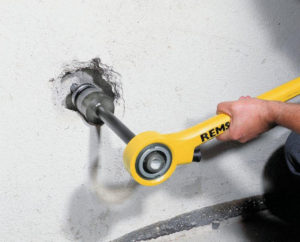
Many may think why buy a screw clamp when you can turn to a turner who will cut threads of any size, diameter and shape. The tool is mainly designed for exceptional cases where you need to cut threads on site. This device is really very convenient to use, it always helps to solve problems with a steel pipeline when it becomes necessary to make a threaded connection.
If welding is preferred instead of a threaded connection, then one important nuance should be understood - when welding, a section is formed inside the pipe, which will cause blockages to accumulate. If the weld is of poor quality, a leak may occur over time, so the only right decision is to buy a pipe die and cut the threaded turns in the right amount.
https://youtube.com/watch?v=POlwUW4NKE8%3F
